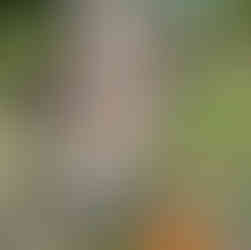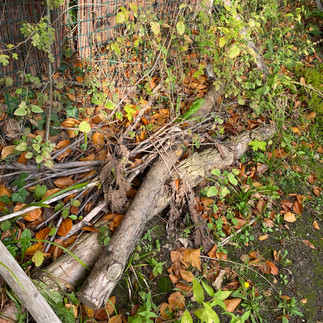Dead wood - dead good for your garden
- sallylouiseedge
- Nov 21, 2022
- 4 min read
Why dead wood is a must in a wildlife friendly garden
Dead wood is bountiful in the Langdon garden and we love it. We have learned and witnessed over the last few years that the dead wood - the dead limbs, stumps. fallen branches, log piles - are are absolutely full of buzzing, scuttling, pecking, burrowing life - habitats and food sources to thousands of species.
"The UK has around 2,000 invertebrates that are saproxylic – that is, reliant on dead or decaying wood for part or all of their life cycle." (RSPB, 2018)
These thousands of insects are in turn a source of food for birds (we get a lot of woodpeckers here for example) and mammals (field mice, voles and hedgehogs too).

This thriving mini-ecosystem also includes silent and mostly unseen organisms. The decaying wood is decomposed by many different species of saprophytic (deadwood-feeding) fungi. These fungi recycle the nutrients from the tree, nourishing the soil around it. Right now at Langdon the fruiting bodies (i.e the fungi that we can see above ground) are popping up everywhere - including many which are feeding on dead wood.
Images below are all dead-wood feeding fungi at Langdon: 1. Turkeytail (Trametes versicolor) - growing in the wood chip path, 2. Dyers mazegill (Phaeolus schweinitzii), growing in the lawn on old tree roots, 3. Honey fungus (Armaillaria spp), growing on a dead beech tree (see more further down on honey fungus)
What different types of dead wood are there?
You don't need to have a big garden to have some dead wood somewhere. It can be something as simple as a few logs and twigs piled up. Here are some of the different types of dead wood we have here.
Piles of sticks and branches

Windfall sticks and woody prunings. I pile them up around the edges of the garden. Log piles look very attractive too.
Dead hedges

This is a brilliant step up from just piling up your woody garden waste as I've been doing. Instead, hammer posts into the ground in two rows. Then stack the wood neatly between posts to form a boundary - like a hedge, but a dead one. I have plans to set a few of these up at Langdon. This pic of of one in my sister-in-law's garden.
Standing Deadwood & Monoliths

Trees that are dead or in the process of dying, with some dead limbs, are also highly valuable to wildlife. Eventually the wind fells them, or we humans decide to for safety's sake, but for as long as they can be left standing they are wildlife treasure chests.
Until it was knocked down in the storms of Feb 2022, this dying silver birch was a favourite of a green woodpecker. You can see the woodpecker's work here.

The bare branches of dead wood are visible perches for displaying birds looking for a mate.
This dying ash next to the pond was a favourite perch for many birds, including this cormorant who was a regular visitor. I think he was more likely contemplating the fish in the pond below than displaying though.

In November 2021 we took the decision to remove the crown of the dying ash as the risk from falling limbs was too great.
But it wasn't necessary to fell the whole tree and so the trunk remains. This is called a monolith. In its new form, the ash (and its cloak of ivy which is a pollinator's paradise in itself) continues to provide habitat and food to countless organisms - and hopefully will do for many more years to come.
Stumps
Tree stumps can be gorgeous focal points in the garden and there are some amazing images online where they have been transformed into works of art, furniture and flower beds (here's a selection). At Langdon we have overgrown stumps that are mostly 'fungi flower beds' at the moment. Plus this one, which is a focal point in this flower bed and growing a sumptuous top coat of spongey moss.

What about the risk of honey fungus?
Do we also need to be cautious about the risk of dead wood in the garden? I have read many warnings that leaving tree stumps in situ can be an invitation to disease and in particular, the dreaded honey fungus. Honey fungus can be devastating in a garden, quickly spreading and killing trees and perennial plants, with no easy solutions for stopping it.
For the past two years I have been discovering mushrooms in several spots around the garden that I believe to be honey fungus, and so it's definitely a concern. We have a number of conifers that have died back from their tops quite significantly in the last few years, near to where I have seen the mushrooms.
Honey fungus mushrooms? (Armillaria spp) Found in the Langdon garden 2020, 2021, 2022
One way of checking for infection is to scrape back the bark at the base of the tree and look for black rhizomorphs (they look like black bootlaces) that are distinctive to its spread . I have tried this but found nothing, and my local tree surgeon believes the die back is just the natural aging of the trees. So maybe I have nothing to worry about? Certainly there has not been an increase in the number of mushrooms - just a handful popping up here and there - so perhaps it's a less aggressive species (there are 10 honey fungus types and they range in how dangerous they are). Or perhaps my mushrooms ID is off. I will keep watching, and am considering getting one of the tree stumps ground down at least.
On balance however, I believe the wildlife biodiversity benefits of having deadwood in our gardens are enormous, and so important in this time when 41% of UK species are in decline.
Let's not be blind to the possibility of disease, but let's also trust in nature's ability to regulate and heal itself.






















Comments